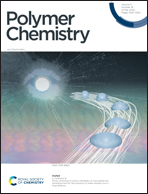Synthesis and enantioseparation of proline-derived helical polyacetylenes as chiral stationary phases for HPLC†
Abstract
Optically active helical poly(phenylacetylene)s (PPAs) have demonstrated themselves as excellent candidates for chiral stationary phases (CSPs) of high-performance liquid chromatography, but the potential of aliphatically substituted polyacetylenes remains unrevealed. Herein, four proline-derived acetylene monomers, (S)-N-aromatic carbamoyl-2-ethynyl pyrrolidine, are prepared and converted to the corresponding conjugated polymers. The asymmetric induction from the directly attached chiral pyrrolidine rings makes the polyene backbones take stable helical conformations with an excess screw sense, which in turn orient the N-aromatic carbamoyl groups to twist along the polymer backbones. The thus formed coaxial double helices endow these polymers with enantioseparation performance comparable to the currently available PPA-based CSPs in terms of the scope of the racemates that can be stereoselectively recognized. Experimental and molecular docking results suggest that the strength of the hydrogen bond and π–π interactions between enantiomers and CSPs are critical for chiral discrimination in addition to the helical polymer scaffold. This work provides an alternative route to develop CSPs with a good enantioseparation ability from biomass other than polysaccharides.



 Please wait while we load your content...
Please wait while we load your content...